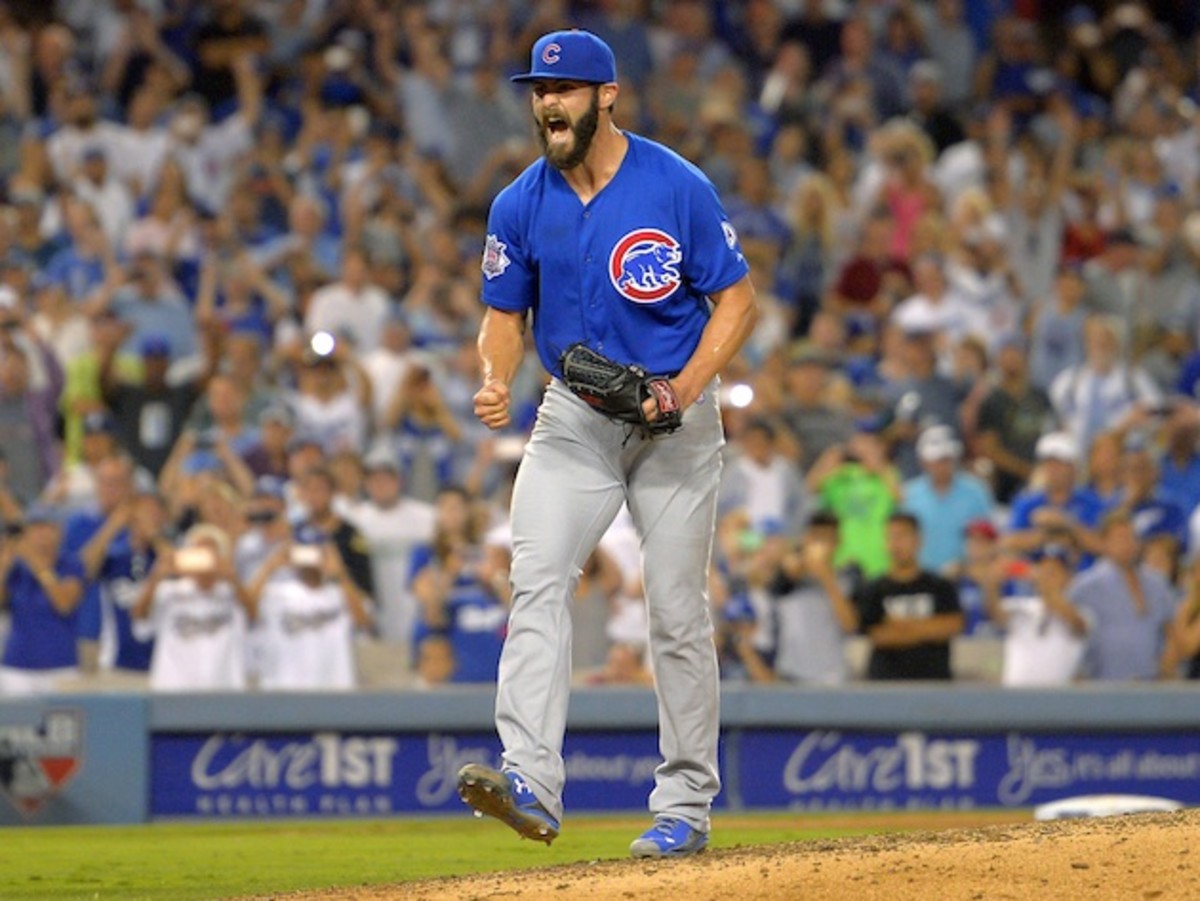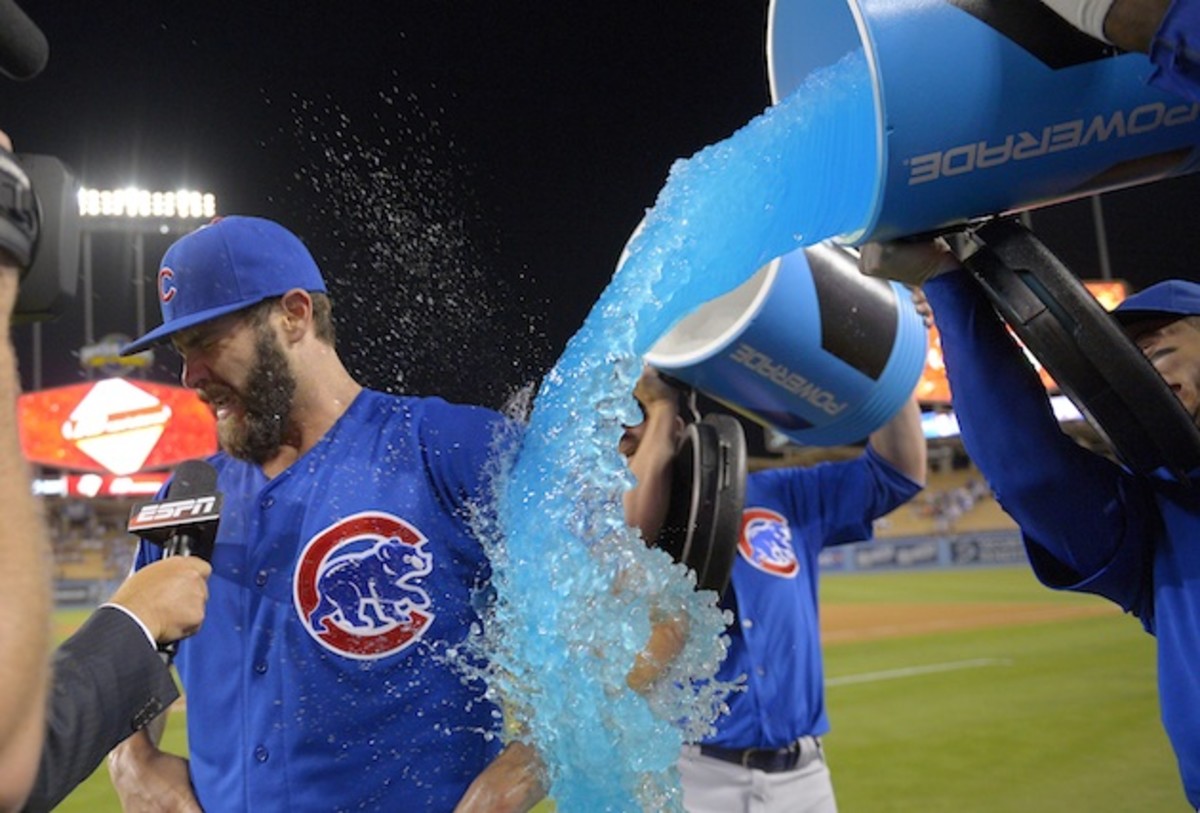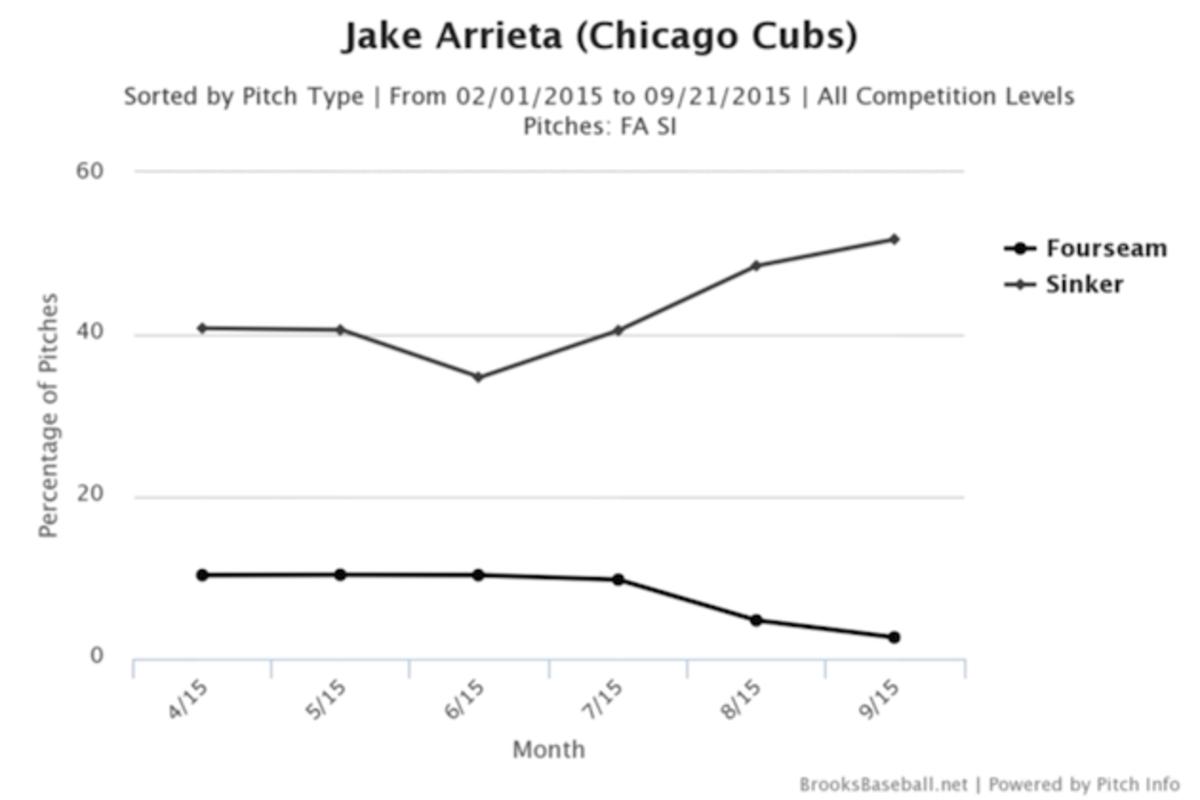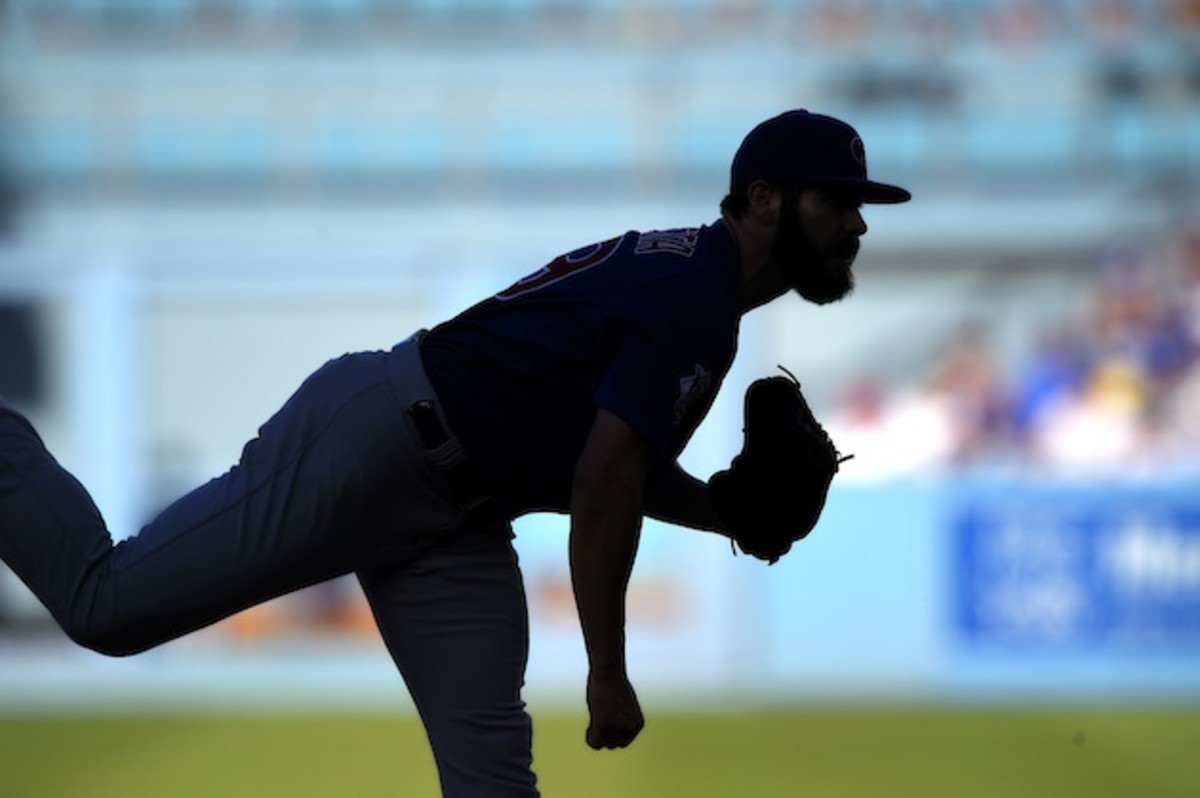Jake Arrieta emerges as unexpected ace as Cubs make playoffs push

When the Cubs handed Jon Lester for $155 million this past winter, they probably figured they had snagged the free-agent prize who would front their rotation for the next half-decade, and—more immediately—help snap a miserable string of five straight sub-.500 seasons.
Only, Chicago general manager Theo Epstein couldn't possibly have known that that his organization already had a Cy Young-caliber arm already on its roster.
To the casual baseball fan, Jake Arrieta wasn't exactly a household name heading into the 2015 season. After a bum shoulder caused him to start the 2014 campaign on the disabled list, Arrieta finished as one of the best pitchers in the Majors last season, compiling top-10 numbers in ERA, FIP, WHIP, and strikeout rate. Amazingly, despite pitching just 156 innings, he ranked third in the NL in Wins Above Replacement, trailing only Clayton Kershaw and Jordan Zimmermann.
• MORE: How did the Cubs become playoff contenders again?
This season, though, he entered spring training squarely in the shadow of his more heralded (and wealthier) teammate. Still, Arrieta has managed to outpitch the coveted Lester, emerging as the top option in the Cubs’ staff. In so doing, the Farmington, Mo., native has become one of the prime reasons his team—currently paced for 93 wins—has exceeded all expectations, giving North Side fans a chance to watch October baseball for the first time in seven years.
*****
Arrieta didn't seem like a potential Cy Young candidate in June. Despite putting together a solid April (2.03 ERA in four starts), Arrieta moved on to May with a mediocre string of starts—his ERA hovered near 4.00. It seemed unlikely he'd best his breakout 2014 effort. Following a four-run, five-inning dud against the Indians on June 16 (his 13th start), Arrieta’s ERA hit 3.40.
That’s as high as it would ever get; that outing being the last time Arrieta failed to complete six innings, and he's reeled off 16 straight quality starts since. Not only is that the longest streak in Major League Baseball this season, it’s the longest by any Cubs pitcher since Lon Warneke in 1933. His brilliant three-month stretch of dominance has launched him into the national spotlight as one of baseball’s elite pitching talents.

Arrieta’s numbers since mid-June have been nothing short of staggering: 13–1 with a 1.00 ERA and 115 strikeouts in 117 innings. It’s a stretch that has included seven scoreless outings, along with a two-hit, one-run complete-game effort against the White Sox just before the All-Star break.
That dominant pre-break performance against the Cubs’ cross-town rival also sparked an even more impressive second-half run for Arrieta, one that is fast approaching historic proportions. With a 0.93 ERA since the break, the 29-year-old is on pace for the lowest second-half ERA (min. 75 IP) by any pitcher since the first All-Star game in 1933. But even those numbers pale in comparison to what Arrieta has achieved since the beginning of August. To wit: 8–0 with a 0.46 ERA in his last eight starts, punctuated by a no-hitter on August 30 against the Dodgers.

According to the Elias Sports Bureau, only one other pitcher since 1913 (when earned runs became official) has gone 8–0 with an ERA below 0.50 over an eight-start span within the span of a single season. That pitcher was Hall of Famer Bob Gibson, who threw six shutouts over eight starts in June and July of 1968, going 8–0 with a 0.25 ERA during that stretch. Gibson, of course, finished that year with a 1.12 ERA, the lowest single-season mark since the end of the deadball era (post-1920).
This is not to say Arrieta is somehow Gibson’s equal, or even to predict all of this is an inevitable precursor to his first Cy Young Award. Still, it’s hard to ignore Arrieta’s truly astonishing run—a stippling, 90-day, baseball blitzkrieg almost without precedent.
So what, exactly, has been the chief difference for Arrieta since that June 16 flop in Minnesota? How has he been able to transform himself from a solid-but-slumping mid-rotation guy into a record-breaking ace in a mere 12 weeks?
Let's explore.
*****
Though Arrieta boasts an above-average strikeout rate (9.2 per nine innings), it’s actually what he’s doing when he’s not punching out batters that makes him so dominant. As the chart below demonstrates, Arrieta’s strikeout and walk percentages over his dominant streak are basically unchanged from his first 13 starts. His groundball rate, however, has seen a significant uptick since mid-June.

As it turns out, the hike in Arrieta’s groundball percentage has coincided with a slight change in the mix of his hard pitches, coinciding with his ditching the four-seamer in favor of a signature two-seamer. His four-seam fastball had become a liability during the first two months of the season, with batters tallying a .350 average and .600 slugging percentage through June 16, surely prompting him to shelve the pitch.

And while Arreita has had to rely on his sinker more often over the past three months, it’s become even more effective with the increased usage.

Arrieta is able to dominate with his sinker because of his unique combination of power and movement, a balancing act that allows him to generate a high number of both whiffs and grounders. His sinker averages 95.2 mph, which ranks sixth-highest among starters (min. 500 pitches) in 2015. Meanwhile, Arrieta’s whiff rate ranks fourth in that group, to go along with a decidedly above-average groundball rate of 57%.
Interestingly, Arrieta’s sinker isn’t the only reason for the increased groundball percentage. His three off-speed pitches—a changeup, curve, and slider—have also generated worm-burners since mid-June.

Not surprisingly, Arrieta’s elevated groundball rate has led to a sharp decline in extra-base hits allowed. It’s not hard to make the connection: By trading flyballs for grounders, Arrieta has been able to limit the damage when batters put the ball in play. In his first 13 starts, he gave up eight homers in 82 innings and a slugging percentage of .373; in his last 16 starts, he’s surrendered just two homers in 117 innings, with opponents slugging a pithy .229 against him.
Impressive as these numbers are, you don’t post a 1.00 ERA for nearly three months simply by inducing more groundballs and allowing fewer homers. Indeed, a huge part of Arrieta’s dominance has been a considerable improvement in his ability to strand baserunners and pitch under pressure. He's allowed just seven hits in 70 at-bats (.100) with runners in scoring position over the last 90 days—this after getting tagged with a .291 average through mid-June. Granted, some of this might be attributed to better defense (and a bit of good luck), but the results are undeniable. Namely, his producing one of the more stunning stretches of pitching in recent memory.
*****

Arrieta will put his nearly unblemished three-month run on the line Wednesday night when he faces the Pirates in what could be a potential playoff preview. If neither team is able to catch the Cardinals in the division race, the Cubs and Pirates will likely face off on Oct. 7 in the NL Wild Card game. (The Pirates, ironically, were the first victim of Arrieta’s current eight-start unbeaten streak, when he tossed seven scoreless innings in the Cubs’ 5–0 win on Aug. 4.)
David Ortiz built Hall of Fame career with 500 homers, playoff stardom
Those looking for Arrieta to be rattled by the moment—the Pittsburgh crowd is sure to whip up a playoff-like atmosphere—would be wise to look at the numbers. In 21 innings against the Pirates this season, Arrieta has yielded just two earned runs and a 0.86 ERA, often looking his best working in enemy territory. He's an impressive 12–1 with a 1.72 ERA over 16 road starts, versus a 7–5 record and 2.33 (13 home runs) at home.
The Pirates aren’t the only top-tier team Arrieta has managed to cast under his spell, either, having pitched considerably better in 2015 when facing the cream of the league's crop. He's tallied a 1.34 ERA over 15 starts against teams with a winning record—the lowest among all Major League starters.
Thanks to a few noteworthy mid-season adjustment, Arrieta has blossomed into one of baseball’s elite aces, authoring an unprecedented stretch of pitching domination and pushing the long woebegone Cubs into genuine, real-life contention. And even if he somehow descends from the stratosphere Wednesday night, the Cubs have to feel good about their chances in a potential showdown with the Pirates in the postseason—a matchup that will determine which franchise gets the opportunity exorcize long-standing demons.

